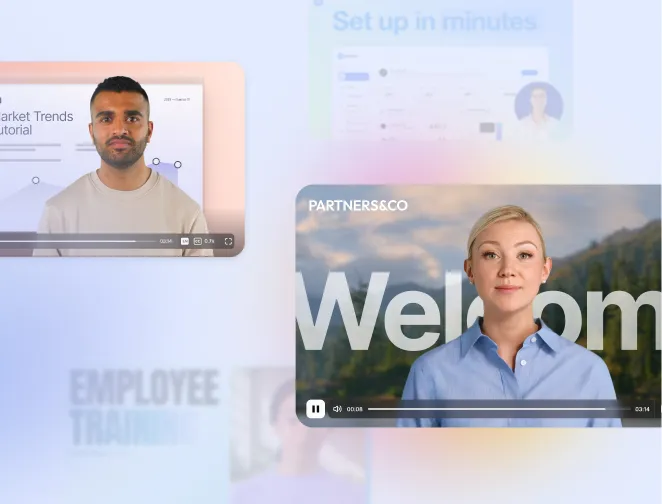
Create AI videos with 230+ avatars in 140+ languages.
I see the same pattern in L&D: people click play, zone out within minutes, and retain almost nothing. Passive watching doesn’t stick, so completion looks fine while behavior doesn’t change.
Switching to interactive training videos flips that script.
In my work with hundreds of teams, I've seen that adding interactive elements like decision points and quizzes boosts knowledge retention by 25% and cuts abandonment by 68% (and this is backed up by peer-reviewed research).
In this guide, I'll show you how to create awesome interactive training videos in Synthesia.
What makes training videos interactive?
Interactive training videos are fundamentally different from traditional video content because they require viewer input to progress.
Instead of passively watching, learners actively participate through quizzes, branching scenarios, clickable hotspots, or calls-to-action.
Think of it as the difference between watching a cooking show and actually following along in your kitchen—one entertains, the other teaches.
The spectrum of interactivity ranges from simple to complex.
On the basic end, you might embed a quick knowledge check every few minutes.
On the advanced end, you could create branching scenarios where each decision leads to different outcomes, mimicking real-world consequences.
The beauty is that these interactive elements can layer onto any video format you're already using—whether that's talking head videos, animations, or screencasts.
Why do they work so well?
Interactive elements directly address the biggest pain points in traditional training: they combat boredom by requiring participation, improve retention through active learning, cater to different learning styles, and provide immediate feedback.
In my experience working with L&D teams, even adding just 2-3 interaction points to a standard training video can dramatically improve engagement metrics.
How to create your own interactive training video in Synthesia
Now that you've seen what's possible, let's walk through exactly how to create your own interactive training videos. I've helped dozens of teams implement this process, and it's simpler than you might think.
Step 1: Define your learning outcome and scenario
Start by answering one question: What should learners be able to do after watching this video?
Be specific. Instead of "understand customer service," aim for "handle an angry customer complaint professionally." This clarity will guide every decision you make.
Step 2: Draft your baseline video in Synthesia
Create your core content first. Choose your AI avatar, write your script, and build the foundation of your video.
Don't worry about perfection—you can always refine it later. Synthesia makes this process straightforward with a wide variety of templates and AI assistance.
You can also check out my guide to creating a video in Synthesia.
Step 3: Identify natural interaction points
Watch your draft and mark spots every 30-90 seconds where interaction makes sense.
Look for moments where learners might have questions, need to make decisions, or should check their understanding.
In my experience, 2-4 interaction points per 5-minute video hits the sweet spot.
Step 4: Add branching for scenario-based paths
For decision points, create alternate video segments showing different outcomes.
Each branch should feel meaningfully different to justify the interaction. Remember, you're not creating a maze—you're providing safe practice.
Step 5: Insert knowledge checks with quizzes
Add quiz questions that test application, not memorization.
Frame them as "What would you do?" rather than "What did we just say?", this approach ensures learners are processing information, not just watching.
Step 6: Add CTAs to drive real-world action
Include one strong call-to-action that connects the training to actual job performance.
This might be downloading a job aid, scheduling a practice session, or completing a real task.
One pattern I consistently see is that specific, actionable CTAs get 3x more engagement than vague ones.
Step 7: Embed your video or export via SCORM to your LMS
Now you can embed your interactive training video anywhere you like. Alternatively, you can use a SCORM export to integrate your interactive video into your Learning Management System.
Measuring the impact of interactive training videos
You've created your interactive training video, but how do you know if it's working? The video metrics you track will determine whether you can prove ROI and continuously improve your training program.
The beauty of SCORM-compliant interactive videos is that your LMS automatically captures most of this data, but even without exporting to an LMS, Synthesia provides its own video analytics dashboard.
You can track views, average watch time, click rates on interactive elements, and quiz performance directly within the platform.
This means you’ll still get meaningful insights into learner engagement and video effectiveness, whether or not you’re using SCORM integration.
But don't get lost in the numbers. Focus on engagement and retention as your leading indicators—if learners are completing videos and remembering content, the business outcomes will follow.
I've found that teams often struggle to connect training metrics to business ROI directly. That's okay. Start by showing improved engagement and completion rates, then gradually build the connection to performance metrics.
The key is establishing a baseline before implementing interactive elements so you can demonstrate clear improvement.
Ready to transform your training with interactive videos?
Your employees expect engaging, relevant content that respects their time and helps them perform better.
I know creating interactive training videos might seem daunting, especially if you're juggling multiple priorities with limited resources. But here's the thing: you don't need to revolutionize your entire training program overnight.
I suggest starting with one high-impact module—maybe a customer service scenario or a critical compliance topic—and add just 2-3 branching points. Try using one of our interactive training video templates to get a quick start.

Ready to see the difference interactive elements can make? Try Synthesia's free AI video maker and create your first interactive training video today. Your learners (and your engagement metrics) will thank you.
About the author
Strategic Advisor
Kevin Alster
Kevin Alster is a Strategic Advisor at Synthesia, where he helps global enterprises apply generative AI to improve learning, communication, and organizational performance. His work focuses on translating emerging technology into practical business solutions that scale.He brings over a decade of experience in education, learning design, and media innovation, having developed enterprise programs for organizations such as General Assembly, The School of The New York Times, and Sotheby’s Institute of Art. Kevin combines creative thinking with structured problem-solving to help companies build the capabilities they need to adapt and grow.

Frequently asked questions
What is an interactive training video, and how is it different from a regular video?
An interactive training video requires viewer participation to progress, transforming passive watching into active learning through elements like quizzes, branching scenarios, and clickable hotspots. Unlike regular videos where viewers simply press play and watch, interactive videos create decision points that mirror real workplace situations, allowing learners to practice skills safely and see the consequences of their choices.
This fundamental shift from watching to doing dramatically improves learning outcomes. Research shows interactive videos boost knowledge retention by 25% and reduce abandonment rates by 68% compared to traditional video content. The beauty is that you can layer these interactive elements onto any existing video format, whether it's talking head presentations, animations, or screen recordings, creating engaging experiences that stick with learners long after they've completed the training.
How can I create an interactive training video in Synthesia in just a few minutes?
Creating an interactive training video in Synthesia follows a straightforward process that starts with defining your specific learning outcome and drafting your baseline video content. Once you've chosen your AI avatar and written your script using Synthesia's templates and AI assistance, you'll identify natural interaction points every 30 to 90 seconds where learners might need to make decisions or check their understanding.
The key to quick creation is starting simple with just 2 to 4 interaction points per 5-minute video. You can add branching scenarios that show different outcomes based on learner choices, insert knowledge checks that test application rather than memorization, and include clear calls to action that connect training to actual job performance. This approach lets you transform standard training content into engaging interactive experiences without the complexity of traditional video production.
Can I add branching scenarios, quizzes, and clickable hotspots or CTAs in Synthesia without extra tools?
Yes, Synthesia enables you to create comprehensive interactive training videos with branching scenarios, embedded quizzes, clickable hotspots, and strategic CTAs all within the platform. The system integrates seamlessly with authoring tools like Easygenerator and Articulate 360, allowing you to add these interactive elements without the hassle of exporting and importing video files between different applications.
This integrated approach means you can build decision trees where each choice leads to different video segments, add knowledge checks that provide immediate feedback, create clickable areas that reveal additional information, and embed calls to action that drive real behavior change. The platform's user-friendly interface makes it simple to layer these interactive elements onto your AI-generated videos, creating professional training content that engages learners and improves retention without requiring technical expertise or additional software investments.
Can I export interactive videos as SCORM and track results in my LMS and within Synthesia?
Synthesia supports SCORM export functionality, allowing you to integrate your interactive training videos directly into your Learning Management System for comprehensive tracking and reporting. This means you can monitor completion rates, quiz scores, engagement at interaction points, and time spent on different sections, all captured automatically through your LMS's standard reporting features.
Even without SCORM integration, Synthesia provides its own video analytics dashboard where you can track views, average watch time, click rates on interactive elements, and quiz performance directly within the platform. This dual tracking capability ensures you get meaningful insights into learner engagement and video effectiveness regardless of your technical setup, helping you demonstrate ROI and continuously improve your training programs based on real user behavior data.
Which metrics should I track to measure the impact of interactive training videos?
The most essential metrics for interactive training videos include completion rates (which typically increase from 85% to 97% with interactivity), engagement at interaction points, quiz scores, and time-to-competency measurements. Focus on tracking both first-attempt accuracy and improvements over time, while also monitoring how quickly learners apply new skills in their actual work environment to gauge real behavior change.
While it's tempting to track everything, concentrate on engagement and retention as your leading indicators since these directly correlate with business outcomes. Start by establishing baseline metrics before implementing interactive elements so you can demonstrate clear improvement, then gradually build connections to performance metrics like reduced error rates, faster task completion, or improved customer satisfaction scores. This focused approach helps you prove the value of interactive training without getting lost in data that doesn't drive actionable insights.














